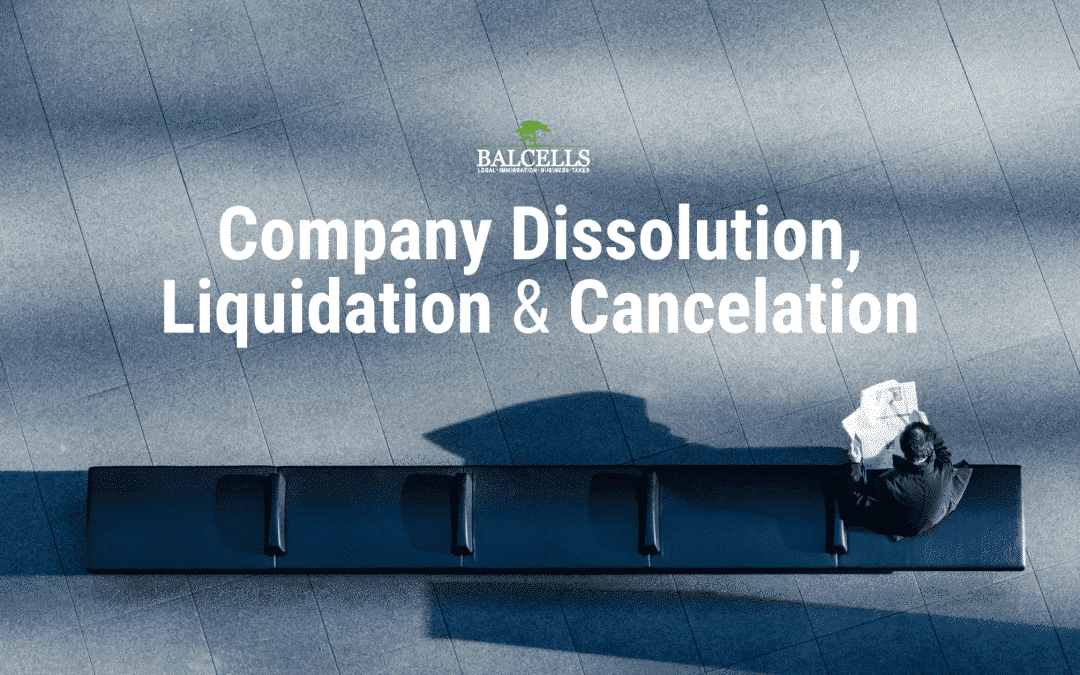Whatever the reason, it is really common to see companies go out of business. That’s how the entrepreneurial world works. How to do it step by step and how the process works is something that generates many doubts, but in this article we will analyze it in an easy and complete way. Thus, we are going to study how to dissolve and liquidate a limited company in Spain, what are the main reasons or cases to do it and we will answer the most frequent questions that any interested person could ask about canceling an S.L.
How do I close my business in Spain?
Many business owners are forced, at one time or another, to close their business. This is a common occurrence in the world of entrepreneurship, and it happens more often than we might think.
Every two hours ta company closes. 15 companies go bankrupt every day. More than 5,000 businesses are closed in Spain every year. The figures are alarming, but that is the reality.
There are several reasons for this: inability to find a market niche, lack of a good marketing strategy to beat competitors, internal problems and business culture, poor financial ratios, etc.
Although many times several of these problems occur at the same time, in other cases only one of them is enough to put the business to death.
Because of its ease of opening and because it is the ideal structure for creation, most of the companies that close are limited companies (also as they are the most common corporate structure).
So if you want to learn how to close your business in the Spanis territory, keep reading.
The aim of this article is to analyze in detail how this closure or cessation works from the legal point of view. That is, to analyze the dissolution of a limited liability company in detail, understanding its causes and consequences.
The company closing process consists of three different phases:
- Dissolution
- Liquidation
- Extinction
Are liquidation and dissolution the same?
No, they are not the same. These are two separate parts of a company cancellation process.
As we will see in a moment, the dissolution is the first step of the process, in which the decision to close the business is reached and the process is started. It can be a voluntary liquidation, or a forced one (forced closure).
On the other hand, the liquidation is the subsequent phase in which the financial situation is analyzed and the company tries to pay all of its existing debts.
Dissolution
The first step in this company closing process is dissolution, and it begins after the shareholders have agreed to at the general meeting.
At this stage, the company maintains its legal personality, by which it continues to exist and is still registered as such. However, it stops making profits or generating income as it has been doing until now.
Thus, the dissolution does not mean a cessation of the activity, simply a change of it. The main purpose of the company (and therefore its activity) will now be to be liquidated.
This dissolution must be registered in the Mercantile Registry, and the legal name of the company will change, adding the extra “en liquidación” (“being liquidated”) at the end.
Once the company is dissolved and this first stage comes to an end, three different things can happen:
- The company can be liquidated, in which the company stops operating once for all (which we will see below)
- It can be transferred, i.e. sell the property of the company to a third party
- Filing for bankruptcy (“concurso de acreedores”), if the company cannot afford to formalize the corresponding payments it owes to its creditors
What are the causes that can lead to the dissolution and liquidation of an S.L.?
There are three different causes that can lead to the dissolution and liquidation of a company. Understanding each one of them is fundamental, since there are reasons that can lead to the dissolution of the company even if the owners are not prepared for it.
Full dissolution (“Disolución de pleno derecho”)
Full dissolution occurs automatically without the need for agreement at the general meeting of shareholders.
It refers, for example, to those cases in which the terms of operations established in the statutes have expired and there has been no extension. That is to say, it is possible that when the business was set up, its owners specified in the statutes that it would only work for, say, 2 years. Once this period is reached, and if it has not been extended, the company is simply dissolved.
On the other hand, bear in mind that the liquidation phase in insolvency proceedings (which we will now see) will also produce a full liquidation.
This first reason for dissolution is regulated in Article 360 of the Law on Corporations in Spain (“Ley de sociedades de capital”).
In this case, the dissolution will take place by resolution of a judge or by a legal reason established in the statutes of the company.
Basically, it happens when any situation or inconvenience occurs that makes it impossible to continue with the objective or purpose for which the company was created.
The most common causes here are:
- The fact that the main activity of the company has stopped.
- Because there is a paralysis of its social bodies, something that would make it impossible for the normal functioning of the company to continue.
- Because of losses, which cause the net worth to be reduced to half of the share capital.
- Reduction of the social capital below the minimum established by law.
- Finally, for any reason that has been established in the statutes previously. Perhaps there was a clause that established the need for dissolution in case X happened. If X happens, the company must be dissolved.
Voluntary causes
And finally, one of the most common causes: shareholders deciding voluntarily to close the company.
In this case all the partners decide, in a general meeting and in a totally voluntary way, that the operations of the company must come to an end. There is no external reason that apparently forces the company to close, but the owners are the ones who, for their own reasons and ideas, take that decision.
To do so, they need the votes of more than half of the share capital at the shareholders’ meeting.
This is certainly a fairly common situation, especially when facing a voluntary dissolution.
Let’s suppose that many of the shareholders of the company express their will to dissolve the company. Nevertheless, there is one of the partners who does not want or is not willing to accept it. What to do?
The first step will be to call a General Meeting, whose objective will be only and specifically to deal with the dissolution of the company.
At this point, everything depends on the distribution of the social capital and the percentage of property/participation that the shareholder/s who oppose the dissolution have.
In case the shareholders who want the society to be dissolved have the majority of the capital, the dissolution will proceed without roadblocks as we will see next.
But in case the majority is held by the partners in favor of the non-cessation, or if there is a clash in equal parts (50%-50%), it will be necessary to go to court so that a judge can define the final decision.
In the latter case, evidence to justify the cause of the dissolution must be provided.
Liquidation
The next stage when closing an S.L. is the liquidation process.
At this step, the company continues to maintain its legal personality. Now, any kind of activity of the company is completely ceased (it is already dissolved).
The administrators no longer have the power of representation (they are removed from their position), and most often they become liquidators (although in some cases liquidators that are new to the company are appointed).
The role of these liquidators is to pay debts to suppliers and creditors (in order of priority). But even before that, they must check that there are no pending operations: if the company had any active credit, they must collect it.
Once these debts of the company are completed, a balance sheet and inventory of the business will be made on the day of the liquidation to analyze which are the assets to be liquidated among the partners and the social capital will be divided according to what is defined in the statutes.
Finally, and obvious as it may sound, all interested parties (partners and creditors) are informed of the state of liquidation.
It will be these administrators who, after analyzing the patrimonial and financial situation of the company and understanding what is the amount and quantity of the existing debts to be paid, will be able to define if the company can face all these liabilities or not.
If not, an insolvency proceeding will have to be initiated.
Bankruptcy proceedings
In case the company is not able to pay all its debts, it must apply for an insolvency proceeding and declare bankruptcy. It is called “concurso de acreedores” in Spanish.
There are two types of bankruptcy proceedings:
- Voluntary bankruptcy, if requested by the company itself when unable to cope with the debts
- Forced bankruptcy, if it is the creditor who solicits it when she is failing to receive any kind of payment
As we will see below, the specific type of bankruptcy is of utmost importance, especially for owners and managers.
It consists of the following phases:
Common phase
The common phase is the first stage, and through it the following tasks should be carried out:
- Apply for the bankruptcy proceedings
- Obtain a court order, which will either approve or deny the application
- Define and make a list of the assets in possession of the company
- Create a report detailing all the company’s current liabilities and debts
Agreement phase
In this second part, the company and its creditors meet to propose schedule different deadlines to ensure that the company can continue its operations. That is to say, debts are renegotiated in such a way as to guarantee the continuity of the company over time.
For this purpose, a vote is held between creditors and the company. If this vote is approved, it will be the judge who will rule that the agreed conditions finally come into force.
Thus, many may wonder why the creditors, seeing that the company owes them money and debt has not been paid, decide to sit down and find ways to renegotiate the debt (something that in many cases will mean a reduction of the final payment they end up receiving and thus more favorable payment conditions for the company).
The answer is very simple. The creditor wants to collect as much money as they can, and 1 is always greater than 0. If the company doesn’t continue its operations, the creditor will probably get a much smaller fraction (or none at all) of what they would get if they do their best to keep the company operating and generating income to pay off the debt, even if it’s in the medium or long term.
Liquidation Phase
If in the previous phase no agreements are presented or those presented are not approved, the company is directly liquidated.
In that case, a bankruptcy administrator will enter the game (the current administrator of the company is dismissed from his position), who will list all the assets and repay the companies debts following the legal order of the creditors.
Thus, the administrator will go one by one with all the creditors, trying to liquidate the maximum amount possible of the company’s debts respecting the order of priorities.
Qualification phase
Finally, there is the qualification phase, which can adopt two different forms or results.
Depending on whether fraud or gross negligence is detected that may have led to the current situation of inability to pay, this competition can be classified as either incidental or culpable.
And, obviously, one rating or the other has important consequences.
In the case of declaring the bankruptcy as guilty, the administrators may be disqualified from managing the assets of third parties, and may be unable to administer companies in the future. And, in the most detrimental of the consequences, the resolution would go against the administrator’s wealth (obliging him to pay part or all of the debts with his personal assets).
Extinction
When the company has already been liquidated and the assets have been divided, the liquidation and cessation of the company must be registered at the Commercial Registry, through an agreement and public deed (the so-called extinction deed).
In other words, you must provide an extinction or cessation request, which will definitively close the registry entries.
This agreement must have 1/3 of the votes corresponding to the company’s shares in order for it to be valid, and is regulated by Article 198 of the Spanish Law on Corporations.
The company must cancel its registration with the Tax Agency, filling out and submitting form 036, definitely finishing its activities and life as a company.
Regardless of the provisions stated in the statutes referring to how the financial year works (from which month to which month), once the termination is registered in the commercial register, this financial year will be considered to have ended, and the company will have to pay corporation tax within the following 25 days.
Taxation during the process
There are a number of extra considerations that you should take into account as they are crucial. Of course, they have to do with taxes.
Throughout the process, the company continues to have legal personality, so it is still subject to corporate tax. And it will do so until the date of cancellation established in the Mercantile Registry.
In the case of disposing of assets, these will be valued at market price. The book value will be increased by 25-30% depending on the size of the company.
If the company still has finished products or materials in stock and these are distributed, the transaction will be subject to VAT.
And, on the other hand, all those partners who receive liquidated assets (and since in most cases they will be individuals) will have to pay 1% as tax on property transfers tax, within the modality of corporate operations.
In addition, this profit made by each shareholder must be declared in their income tax return.
Would you like to liquidate or dissolve your company but do not know where to start? Do you need specialized legal advice to navigate through the entire process easily and successfully? Then let us help you out. Our team is at your complete disposal.
Book a consultation with one of our lawyers and solve all your doubts:

At Balcells Group we have been foreigners effortlessly moving to Spain for over 11 years. We help expats from all around the world with their immigration, business, tax and legal needs; ensuring a legally safe and enjoyable transition to the Spanish territory. Our multilingual team understands the importance of adapting to the cultural and legal specificities of our international clients. We offer a comprehensive service that combines the expertise of several generations of lawyers with the innovation needed to address today’s legal challenges, always striving to simplify processes and ensure reliable, effective results.



